Choosing the Right Home Charging Technology for Your EV

As the world pivots towards sustainable transportation, the electric vehicle (EV) movement is gaining significant traction. Australia, with its vast landscape and budding green initiatives, is a prime market for EVs. For EV owners Down Under, the decision to make the switch to an electric car is often just the first step in a journey towards a greener, more energy-efficient lifestyle. Equally important is the careful selection of home charging technology — a decision that can significantly impact convenience, daily routine, and long-term satisfaction with your electric vehicle.
The Importance of Home Charging
While public charging stations are increasingly available, the convenience of home charging cannot be overstated. Imagine the simplicity of waking up to a fully-charged vehicle every morning – it's the promise of EV ownership that makes daily commutes or impromptu trips hassle-free. But with a growing range of charging technologies, how do you determine what's best for your EV and lifestyle?
Understanding the Options
Australian EV owners are presented with three primary home charging options: Level 1, Level 2, and DC Fast Charging. Each comes with its own set of characteristics and caters to different needs.
Level 1 Charging: The Entry Point
Level 1 charging is the most basic home charging option, utilising standard 120-volt outlets. It's the slowest method, delivering about 2 to 5 miles of range per hour of charging. This option is typically included with your EV purchase, requiring no additional installation beyond an outlet adapter.
Pros of Level 1 Charging
- No extra equipment needed; typically included with your EV
- Suitable for overnight charging and topping off
Cons of Level 1 Charging
- Slow charging rate can be impractical for longer commutes or larger battery EVs
- May require dedicated 15-amp circuit for safety and efficiency
Level 2 Charging: A Step Up
Level 2 charging operates on 240 volts, offering a much faster pace at around 10-60 miles of range per hour. It often requires professional installation and the purchase of a home charging station (also known as an Electric Vehicle Supply Equipment, or EVSE), but can be a game-changer for EV owners with daily driving or larger battery needs.
Pros of Level 2 Charging
- Faster than Level 1, providing more miles of range per hour
- Customisable features like timers and Wi-Fi connectivity for added control
Cons of Level 2 Charging
- Requires a home charging station and professional installation, adding to initial cost and set-up time
- May have location limitations based on where it can be installed on your property
DC Fast Charging: On the Go
DC Fast Charging, also called Level 3, is not a home-based solution but is pivotal for Australian drivers needing quick charges during long trips. This technology can provide up to 150 miles of range in just 30 minutes, significantly reducing wait time at charging stations.
Pros of DC Fast Charging
- Rapid charge times make it ideal for longer journeys
- Access to statewide and national EV networks with fast-charging stations
Cons of DC Fast Charging
- Typically more expensive to use than Level 1 and Level 2 charging
- Not suitable for regular, daily charging due to potential battery wear over time
Factors to Consider When Choosing a Home Charger
Before committing to a home charging technology, several factors warrant your attention. These include the upfront cost, installation requirements, compatibility, and personal or household charging needs.
Cost and Installation
Level 1 chargers are the most cost-effective, requiring little beyond a standard outlet. Level 2 chargers, on the other hand, can range from a few hundred to several thousand dollars, factoring in the cost of the unit and professional installation. DC Fast Charging, often an outdoor solution, could cost several thousand to install but may provide rebates or incentives, particularly if you live in an apartment or do not have dedicated parking.
Compatibility with Your EV
Not all EVs are engineered to charge at the same rate. Ensure that the home charging technology you choose aligns with your vehicle's capabilities. You'll want to consider your car's onboard charger and its maximum input power to optimise the charging experience.
Charging Speed and Convenience
While Level 1 charging is slower, it can be incredibly convenient for some owners, providing ample charge overnight. Level 2 charging is a good middle ground, offering swift charging that can cover most daily commutes and activities. The convenience of DC Fast Charging lies in its ability to rapidly recharge for longer journeys or in emergency situations.
Available Infrastructure
Consider the current and future landscape of charging infrastructure in your area. As Australia continues to invest in EV technology, the accessibility of public chargers may influence your home charging system choice.
The Power of Informed Decision-Making
Selecting the right home charging technology is a significant component of your electric vehicle ownership. It's not a decision to be taken lightly, nor is there a one-size-fits-all solution. By considering the factors outlined above, you can ensure that your home charging set-up aligns with your lifestyle, vehicle, and environmental goals. Take the time to research and make an informed choice — your daily driving experience and overall EV satisfaction depend on it.
As you navigate through the available charging technology, remember that the environmental benefits of EVs go hand in hand with the responsible use and sourcing of energy. It's a commitment to both the planet and a burgeoning eco-friendly community.
Move forward on your path to a brighter future by reaching out to Smart Energy Answers for all your EV charging requirements. Our dedicated team is here to assist you in making well-informed choices that align with your home and sustainability objectives.
%20(1).png?width=265&height=96&name=www.smartenergyanswers.com.auhs-fshubfsSmart%20Energy%20Answers%20Logo%20(HIRES)%20(1).png)

.png?width=514&height=121&name=Tesla%20Powerwall%203%20(new).png)







